Black Shark 2 Review: The Gaming Phone You Really Want
Chinese gaming-phone startup Black Shark is gunning for OnePlus' bargain flagship crown, and it nearly pulls off the heist with a sleek design and stunning performance.
Why you can trust Tom's Guide

We buy consoles and PCs built for gaming, so why not buy gaming-focused smartphones, too? This is the philosophy behind some of the past year's most interesting handsets, from the likes of Asus' ROG Phone and the Razer Phone 2. And now, a new contender has joined the fray.
You may never have heard of Black Shark, and that's for a very good reason: the company was founded only in 2017. Chinese tech giant Xiaomi owns a 46 percent stake in the firm, though Black Shark is adamant that it and Xiaomi don't utilize the same production lines or research and development personnel.
Black Shark's first handset came out almost exactly a year ago and made it outside China only last November, when the phone went on sale in the U.K. and Europe. Now, there's a second device out, and it won't land on American shores either. However, at the low, low price of £479 ($625) — £50 less than the OnePlus 6T — the Black Shark 2 is a bargain of a flagship handset that might just be worth the frustration of importing.
Black Shark 2 Specs
| Price | £479 |
| OS | Android 9 Pie |
| Screen Size (Resolution) | 6.4-inch LCD (2340 x 1080) |
| CPU | Qualcomm Snapdragon 855 |
| RAM | 8GB |
| Storage | 128GB |
| microSD Slot | No |
| Rear Camera | Dual: 48 MP (f/1.8) and 12 MP telephoto (f/2.2) |
| Front Camera | 20 MP (f/2.0) |
| Battery Size | 4,000 mAh |
| Water Resistance | No |
| Size | 6.44 x 2.95 x 0.35 inches |
| Weight | 7.23 ounces |
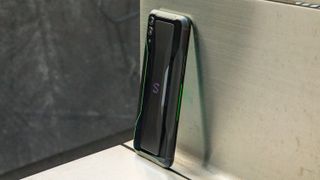
Black Shark hasn't completely ruled out sales in the U.S., but like many Chinese phone makers, the company is staying out of North America for now. That said, you can import the Black Shark 2 to the States, and it will work on some carriers.
T-Mobile is an ideal network for the Black Shark 2, as the company supports Bands 2 and 4, which the Uncarrier primarily relies on for LTE service. AT&T and Verizon also deploy these bands, but to a lesser extent, so coverage may not be as comprehensive on those companies' towers. And don't even think about Sprint, as Now Network subscribers won't have any luck with this bargain gaming phone.
The Black Shark 2's design sports the right dash of personality for a gaming phone, without venturing into caricature.
Black Shark offers a variety of accessories designed specifically for the company's latest handset, the most prominent of which is a pair of Joy-Con-like game-pad attachments that essentially turn the device into a makeshift Nintendo Switch. Strangely enough, Black Shark will ship these products within the U.S. The controller add-on costs $99, and the company also sells a $39 USB Type-C-to-HDMI cable to throw your games over to a bigger screen (though a standard USB-C-to-HDMI dongle will also do the trick just as well).
Design: Game in style
When I think of mobile gaming, two devices specifically come to mind: the minimalist, so-spartan-it's-basically-invisible Razer Phone 2 and the flashy, angular and aggro ROG Phone.
The Black Shark 2 can almost perfectly be described as a midway point between these two extremes. It's not as utilitarian as Razer's handset, but its chamfered edges and curves make it considerably less juvenile than Asus' offering. In fact, Black Shark's design may be my favorite of the bunch, because it has just the right dash of personality without venturing into caricature.

From the front, there's not much about the Black Shark that demands your attention. The 6.4-inch, 18:9 AMOLED display is flanked by a pair of speakers inset within slim top and bottom bezels. The frame is trimmed in a metallic emerald green, which I could honestly do without, though at least it's not extremely noticeable. And there's a fingerprint sensor baked right in to the screen. However, it's of the optical variety, rather than the faster and more secure ultrasonic kind as you'd find in the Galaxy S10. The optical sensor still works well enough, though.
At the back of the Black Shark 2, things get much more interesting. The phone mixes matte aluminum and mirrored glass in a way you don't see very often. The manufacturer likens the device's creases and curves to those of an exotic sports car, and I'm inclined to agree. They make the Black Shark 2 quite eye-catching at a time when most phone makers have trended toward making their products less distinctive.
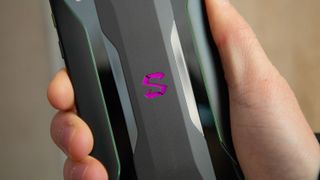
The rounded frame and tapered sides lend the Black Shark 2 some ergonomic merit as well. This phone is a bit easier to handle than most devices of this size, even with the slippery cocktail of materials cladding the chassis. And just like every self-respecting example of gaming hardware these days, the Black Shark 2 packs its share of RGB lighting. The logo on the back lights up but doesn't get particularly bright. You're more likely to notice the strips adorning the left and right edges, which glow and dance as notifications roll in.

The Black Shark 2 is mostly a design win, though buyers should be forewarned that they'll concede wireless charging in exchange for all that metal. (I can live with that trade-off, though I understand that some won't.) There's no water resistance to speak of, either, and I really regret the lack of a 3.5-millimeter headphone jack, which would have taken the audio experience to the next level.
Display: Gimmicks for days
The 6.4-inch AMOLED panel inside the Black Shark 2 is a welcome surprise, given that most handsets selling at this price feature LCD screens instead. That said, it's best to temper your expectations, as this is merely a good display — not a great one.
First off, it's far from the brightest. At a peak of 352 nits, the Black Shark 2 can get only half as bright as the Galaxy S10 Plus, which topped 625 nits in our testing. To Black Shark's credit, though, its device is much cheaper than Samsung's and achieved only 10 nits less than what the Pixel 3 managed.
Strangely, the Black Shark 2 can get brighter — or at least, seem like it — under the right circumstances. When playing a game, you can swipe inward from one of the display's top corners to open the Game Dock, which incorporates lots of options for modifying the audiovisual experience when you're gaming. And it's here that you'll find a Game HDR setting, which boosts the luminosity and contrast of on-screen content while selectively lifting dark areas and dampening bright ones.
At nearly 14 hours of endless web surfing, the Black Shark 2 is one of the longest-lasting phones we've tested so far this year.
The effect is profound, though I suspect that some will find it a bit too saturated. Either way, Game HDR can be used only while playing games. For other activities, the Black Shark 2 offers multiple color profiles, as well as a Video HDR mode, which ratchets up color in much the same way Game HDR does (just for apps, like YouTube), and a Super Cinema mode, which artificially accelerates frame rates of videos in a TrueMotion-style way.
I thought the world had collectively decided TrueMotion was a bad idea, but it rears its ugly head again in the Black Shark 2. Thankfully, you can turn this feature off, which I scrambled to do after watching the trailer for the Fast & Furious spinoff, Hobbs & Shaw. With Super Cinema on, certain scenes will just haphazardly move faster. One minute, you're watching a cheesy action flick; the next, a car chase feels like a Keystone Kops two-reeler.
Video HDR isn't quite as egregious, though it's important to note that the Black Shark 2's panel isn't actually HDR10-certified. In other words, you just get another layer of cartoonishly pumped-up saturation and brightness, which honestly didn't do the trailer I was watching any favors. Video HDR also seemed to impede sharpness, so it felt as though I wasn't getting the most out of the panel's full-HD+ resolution.

Turn off those filters off, however, and the Black Shark 2's display is quite nice. With a Delta-E color-accuracy rating of 0.17, the phone's screen ranks as one of the most true-to-life of any we've tested recently, and on a par with the LG G8 ThinQ. For perspective, the S10 Plus achieved a Delta-E score of 0.29, and numbers closer to zero indicate more-accurate hues.
The Black Shark 2's cameras may not be perfect, but they're a step up for gaming phones.
Additionally, the Black Shark 2 displayed 192 percent of the sRGB color space when set to its default Cinema profile. The similarly priced OnePlus 6T notched 222 percent, giving that phone an edge in saturation. That said, more and more handsets these days, including the iPhone XS Max and Galaxy S10 Plus, have opted for realism over intensity. Those flagships hovered around 130 percent in our testing, and the Black Shark 2 looks to have found a good middle ground in terms of punchiness.
Camera: Some strengths
In their short history, gaming phones have failed to produce fantastic cameras. And though the Black Shark 2's cameras are far from perfect, they're a step up for the category.
Leading the array of two lenses is a massive, 48-MP primary sensor on the back. This shooter incorporates an f/1.8 aperture and pixel-binning technology, which bundles all those megapixels together to produce 12-MP photos with greater detail than you'd typically get from images that size.
The main lens did an admirable job of capturing the skyscrapers encircling New York's Bryant Park, especially compared to the Razer Phone 2. That phone, even at its reduced price of $499, is still too poor of a mobile camera to recommend to anyone. Through the Black Shark's 48-MP lens, the grass is greener, everything's a whole lot brighter and the sky is a truer shade of cloudy gray.
The Black Shark 2 also includes a 12-MP, f/2.2 telephoto lens. A telephoto is the preferable setup for portraits, as it cuts in and gives you that flatter, pulled-together aesthetic for more-dramatic photos. For that reason, I definitely preferred the Black Shark 2's rendition of this shot of some flowers in the park to what the OnePlus 6T managed. OnePlus' device wrangled a richer shade of yellow out of the flowers' petals, but the Black Shark's attempt offers better isolation and separation between the foreground and background, without the bokeh effect peeking through into the subject.
When you're shooting flowers or a person, the Black Shark 2 relies on its AI camera to adjust settings dynamically to suit the nature of the scene. Truthfully, though, this didn't seem to improve the quality of the photos I captured, even in relation to other devices that lack AI scene recognition. The OnePlus 6T delivered a warmer and likely more Instagram-ready self-portrait compared to the Black Shark 2, though I like the sharpness and detail in the photo the gaming phone pumped out.
Finally, the Black Shark 2 can lean on its telephoto lens for a 2x optical zoom. This highlights another spec advantage of this phone over the OnePlus 6T, whose secondary lens doesn't incorporate a tighter field of view and thus needs to rely on software-aided digital zoom for close-ups. As a result, the Black Shark 2's shot is a bit crisper than what the OnePlus can obtain. The BlackShark 2 photo is also more brightly exposed, which helps illuminate details in the statue's shadow. However, that seems to have come at the expense of color intensity. The OnePlus 6T once again delivers more of the yellows, purples and greens you look for in a spring scene like this.
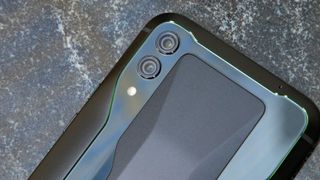
Performance: Zero compromises
With a Snapdragon 855 chipset and 8GB of RAM, the Black Shark 2 certainly has the hardware you want in a gaming phone.
In case you're still doubtful, though, the benchmarks should put any skepticism to rest. In Geekbench 4, which measures overall performance, the Black Shark 2 hit 11,174 points. That's not only higher than the Galaxy S10's 10,813, but also easily within spitting distance of the iPhone XS' 11,420 result.
More important for gamers, however, is 3DMark's Sling Shot Extreme OpenGL ES 3.1 test. And here, Black Shark's latest offering dazzled, with a score of 5,740. That also eclipsed the S10 Plus' best showing, of 5,648, and handily toppled the A12 Bionic-powered iPhone XS's score of 4,339.
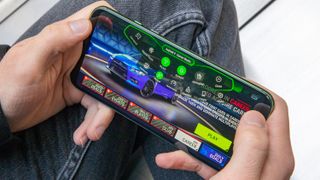
Those are impressive results, particularly in light of the Black Shark 2's bargain price. But they don't feel real until you experience how this phone brushes off the most demanding of games. I bounced back and forth between arcade racer Asphalt 9: Legends and PUBG Mobile, and as hard as I tried, I couldn't get the Black Shark 2 to break a sweat.
MORE: 10 Best Mobile Racing Games
Using the Game Dock, I raised the performance level to what Black Shark calls Ludicrous Mode — a profile in which all the device's resources are fully diverted to gaming. The phone got warm, but not uncomfortably so. And considering I was playing PUBG at its most power-hungry settings — HDR graphics, with anti-aliasing on and the frame rate at Ultra — I'd classify that as a win.
Funnily enough, though, you don't need to use Ludicrous Mode to get that kind of performance. I turned everything down to Level 1, which is designed to maximize efficiency and battery life, and I still never dipped below PUBG Mobile's locked 40 frames per second. But whether you delight in all the nerdy power-management options or not, the Black Shark 2 is equipped to handle any Android game out there right now. And that's what a gaming phone ought to do.
Battery: Endurance champ
The Black Shark 2's svelte chassis conceals a large, 4,000-mAh battery. That's the same size as the one inside the ROG Phone and a hair smaller than the 4,100-mAh power pack inside the Galaxy S10 Plus. But this handset gets more out of its battery than either of those devices get out of theirs.
The Black Shark 2 lasted an impressive 13 hours and 50 minutes in Tom's Guide's battery test, in which devices continuously load web pages over T-Mobile's LTE network until the phones run out of juice. The ROG Phone made it only 8 hours and 59 minutes, while the S10 Plus — which features the same Snapdragon 855 processor as the Black Shark 2 — lasted 12 hours and 35 minutes. That's a terrific time, and yet, the Black Shark 2 topped it.
MORE: Smartphones With the Longest Battery Life
The Black Shark 2's nearly 14-hour result places the device among the longest-lasting phones we've tested thus far this year, eclipsed only by the 15 and a half hours from the Moto G7 Power. However, the Black Shark 2 is exponentially more powerful than Motorola's budget device, and thanks to Quick Charge 4 support, the Black Shark 2 charges much more quickly, too, reaching 60% in a half-hour.
Unfortunately, there's no wireless charging available for the Black Shark 2, but that's a reasonable trade-off given the phone's metal build and low price.
Software and Special Features
Outside of China, where the Black Shark employs an Android front end similar to Xiaomi's MIUI, the Black Shark 2 features a version of Android 9 Pie that very much seems stock on the surface. However, if you look closely, you'll see a lot of additional features tacked onto the software side of things.

Chief among those features is Shark Space. Represented by a mechanical green switch on the right side of the phone, Shark Space instantly pulls you out of whatever you're doing on your phone and sends you to a gaming-focused launcher. At the same time, it clears the device's RAM and silences all notifications.
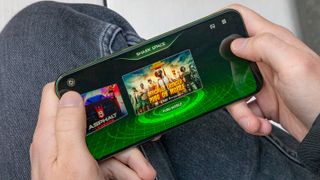
Interestingly, you can't return to the Android home screen — or any other nongaming app, for that matter — when you're locked in to Shark Space. And if you play some games that aren't as popular or well-known, they might not support the Shark Space launcher, so you won't be able to play them that way. This isn't an issue for triple-A franchises, like PUBG, Asphalt or Madden, though it's something to be aware of.
MORE: Best Android Games - Top Rated Games by Category
You never have to use Shark Space to play games, though. And if, like me, you spend most of your mobile gaming while commuting on some form of public transportation, you shouldn't. Shark Space makes it more difficult to dip out of a game and into something else that may require your attention, but then, that's kind of the point, and perhaps I'm not the mobile gamer Black Shark had in mind.
You can control the Black Shark 2's RGB lighting on the back and sides via the standard Android Settings app. Asus' and Razer's handsets have similar lighting but offer far more-extensive options for brightness, colors and profiles to determine when and how those lights come into use. In fact, the lighting inside the logo is quite hard to see unless you're in an especially dark room, though that surely bodes well for battery life.
If I have one minor gripe about the Black Shark 2's software, it's that the device I was using clearly hadn't been translated with care for English-speaking users. This isn't terribly surprising, given that Black Shark is not offering this phone in North America quite yet. Then again, the phone is on sale in the U.K., and its head-scratching language is bound to be a little off-putting to those buyers.
The worst offender came in the description of a feature called Athletic Mode, which says, "in the game, follow the sound effect, intelligent play, dynamic lighting effect." I think I know what that means, but that I even have to guess indicates a problem.
MORE: The Best Phones for Gaming
Beyond software, Black Shark produces a number of gaming-centric accessories for its phones; chief among them is the $89 (£69) Gamepad 2.0 attachment. Unfortunately, Black Shark couldn't provide us with a Gamepad to test at the time of this writing. And although the device's software suggests using the company's snap-on cooling fan while running games in Ludicrous Mode, no such accessory is currently available in Black Shark's store.
Even if you don't have the bonus buttons and analog sticks the Gamepad provides, the Black Shark 2 allows you to customize some touch-screen-based controls via the phone's Game Dock. However, not all the options are available to all games. The phone's display actually supports a 3D Touch-like feature in which deep presses can be mapped as another input, though I couldn't find a way to register this feature in any of the titles I played.
Bottom Line
If you live somewhere you can buy one, the Black Shark 2 is a solid choice for a powerful smartphone on the cheap, whether you're a gamer or not. Regardless of your thoughts on the design, the build quality inspires confidence, and the Black Shark 2's performance and battery life are first-rate. The camera won't contend with the latest from Huawei, Google or Samsung, but it's good enough for the price.
If you live outside the British Isles or Europe, though, the Black Shark 2 becomes a tougher sell. In addition to the headache of importing, there's no guarantee the device will work on your network in all the areas you should receive service.
Plus, there are reasonably priced alternatives more readily available in the U.S., chief among them being the $579 OnePlus 6T, though the Razer Phone 2 is also a better deal now that it costs $499. With the Snapdragon 855-powered OnePlus 7 just around the corner, too, it's hard to imagine you'll save a ton of cash by choosing Black Shark.
That leaves the Black Shark 2 in a spot alongside the greatest handsets coming out of China today, from the likes of Huawei, Xiaomi, Oppo and Vivo. It's a well-rounded phone with astonishing value, but when the market is flooded with so many other great choices that you can own with a fraction of the effort, this device is just not worth the trouble.
Credit: Tom's Guide
Sign up to get the BEST of Tom’s Guide direct to your inbox.
Upgrade your life with a daily dose of the biggest tech news, lifestyle hacks and our curated analysis. Be the first to know about cutting-edge gadgets and the hottest deals.
Adam Ismail is a staff writer at Jalopnik and previously worked on Tom's Guide covering smartphones, car tech and gaming. His love for all things mobile began with the original Motorola Droid; since then he’s owned a variety of Android and iOS-powered handsets, refusing to stay loyal to one platform. His work has also appeared on Digital Trends and GTPlanet. When he’s not fiddling with the latest devices, he’s at an indie pop show, recording a podcast or playing Sega Dreamcast.
